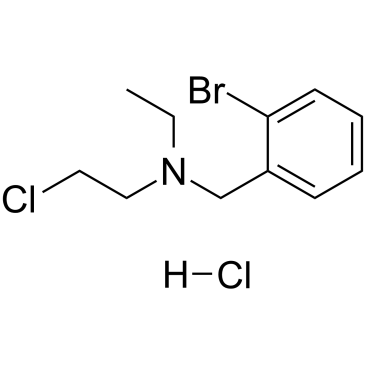A central neuropathic pain model by DSP-4 induced lesion of noradrenergic neurons: preliminary report.
Takashi Kudo, Tetsuya Kushikata, Mihoko Kudo, Tsuyoshi Kudo, Kazuyoshi Hirota
文献索引:Neurosci. Lett. 481(2) , 102-4, (2010)
全文:HTML全文
摘要
Neuropathic pain models are classified as central and peripheral pain models. Although various peripheral neuropathic pain models are established, central pain models are based only on spinal cord injury. DSP-4 is a competitive inhibitor of norepinephrine uptake that selectively degenerates the locus coeruleus (LC)-noradrenergic neurons projection to the cerebral cortex and hippocampus. In the present study, we have tested whether lesion of LC-noradrenergic neurons by ip DSP-4 (0, 10, 30, 50 mg/kg, n=7 each) could provide a new central neuropathic pain model in rats using a hot-plate and tail-flick tests. DSP-4 significantly reduced the hot-plate latency and norepinephrine contents especially in the coerulean regions. However, DSP-4 did not change tail-flick latency. There are significant correlations of the latency in the hot-plate test with norepinephrine contents in the cerebral cortex (r=0.432, p=0.022), the hippocampus (r=0.465, p=0.013) and the pons (r=0.400, p=0.035) but not with those in the hypothalamus and the spinal cord. As response to hot-plate and tail-flick implies supra-spinal process and spinal reflex, respectively, central neuropathic pain may be facilitated by DSP-4 depleting LC-noradrenergic neurons although the present data are preliminary.Copyright 2010 Elsevier Ireland Ltd. All rights reserved.
相关化合物
| 结构式 | 名称/CAS号 | 分子式 | 全部文献 |
|---|---|---|---|
 |
N-(2-氯乙基)-n-乙基-2-溴苄胺盐酸盐
CAS:40616-75-9 |
C11H16BrCl2N |
|
Noradrenergic terminals regulate L-DOPA-derived dopamine ext...
2014-07-01 [CNS Neurosci. Ther. 20(7) , 671-8, (2014)] |
|
c-Fos activity mapping reveals differential effects of norad...
2013-04-03 [Neuroscience 235 , 1-9, (2013)] |
|
Effects of noradrenaline and serotonin depletions on the neu...
2012-01-27 [Neuroscience 202 , 424-33, (2012)] |
|
Cytochrome P450 is regulated by noradrenergic and serotonerg...
2011-10-01 [Pharmacol. Res. 64(4) , 371-80, (2011)] |
|
Antinociceptive effects of neurotropin in a rat model of cen...
2011-09-26 [Neurosci. Lett. 503(1) , 20-2, (2011)] |